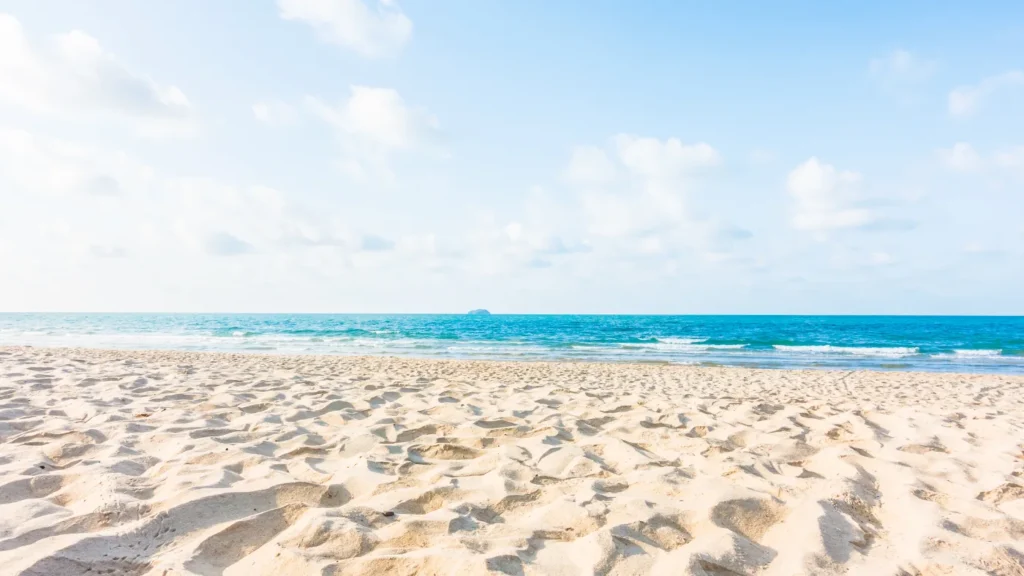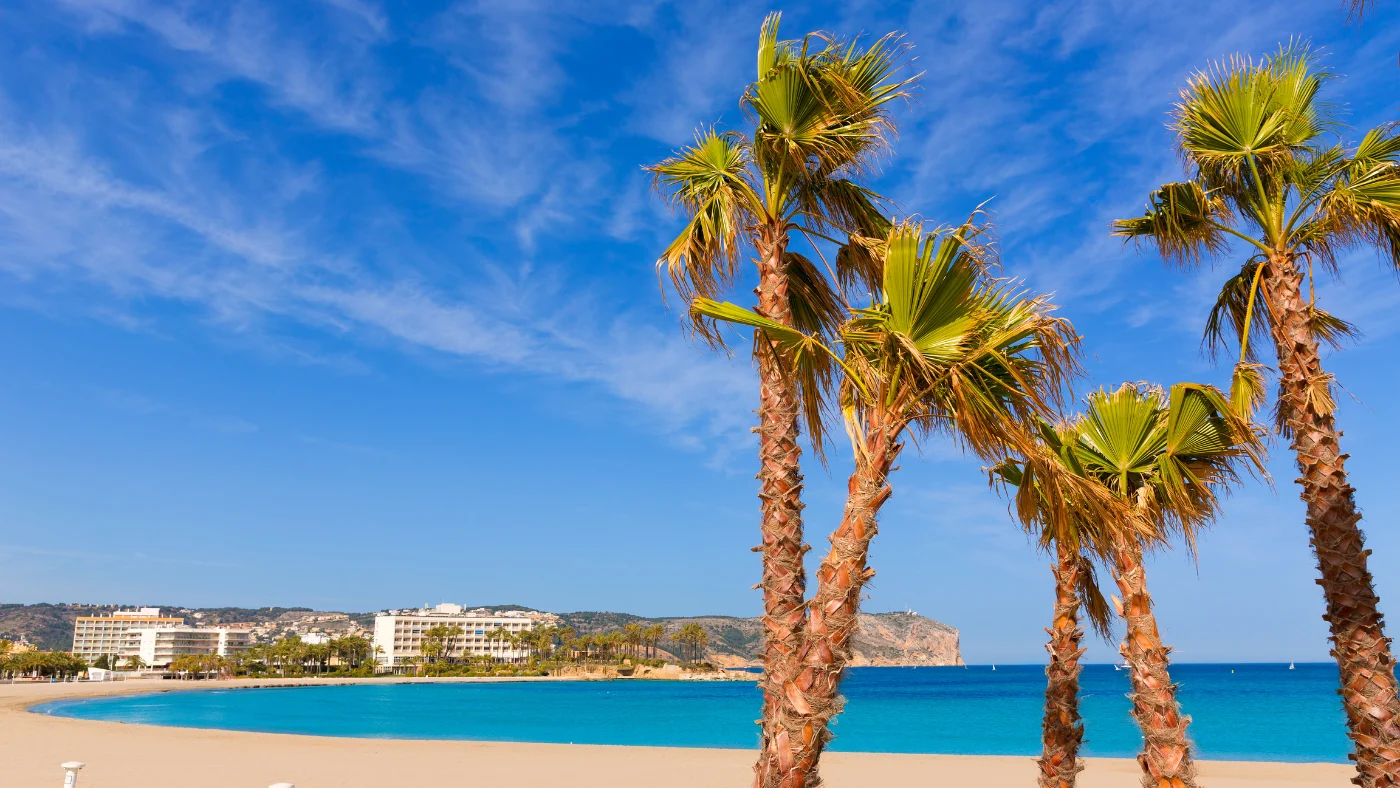Golden sands, turquoise coves, and dramatic cliffs make Jávea beaches some of the most admired in the Costa Blanca. With more than 20 kilometers of coastline, the town offers sandy stretches, rocky coves, and hidden bays that continue to attract travelers in 2025.
This guide provides a clear overview of the best Jávea beaches, combining local insight with practical advice. From family-friendly shores to secluded coves framed by cliffs, it will help you plan a coastal experience that matches both your expectations and your style of travel.
Jávea at a Glance
Jávea, also known as Xàbia, is one of the most celebrated coastal towns on Spain’s Costa Blanca. Set between the Montgó Mountain and the Mediterranean Sea, it offers a mix of dramatic landscapes, charming old town streets , and pristine Jávea beaches.
The coastline of Jávea stretches for over 20 kilometers, blending sandy shores with rocky coves and hidden bays. This variety makes it one of the most versatile beach destinations in the region.
Visitors can enjoy lively family-friendly beaches such as Playa del Arenal alongside quiet retreats like Cala Sardinera. Each location reflects the town’s natural beauty while offering distinct experiences.
Located midway between Alicante and Valencia, Jávea is easily accessible by car in just over an hour from either city’s airport. This convenience, combined with its setting, strengthens its appeal for both international visitors and local travelers.
The local climate provides more than 300 days of sunshine a year, ensuring reliable conditions for beach visits. Mild winters and warm summers make Jávea a year-round destination for those seeking the coast.
Best Jávea Beaches to Explore
The beaches of Jávea combine natural beauty with accessibility, offering experiences that range from lively family areas to remote, untouched coves. Exploring several during your stay allows you to appreciate the diversity that makes Jávea one of the leading coastal destinations in Spain.

Playa del Arenal
Playa del Arenal is the largest and most popular of the Jávea beaches, offering a wide arc of soft golden sand and calm waters. Its Blue Flag status ensures high standards of water quality, safety, and facilities throughout the year.
The beach is fully equipped with lifeguards, showers, and easy access for strollers and wheelchairs, making it ideal for families. The promenade behind it is lined with international restaurants, beach bars, and shops, creating a lively atmosphere that continues well into the evening.
Cala Granadella
Cala Granadella is consistently ranked among the most beautiful coves in Spain, with turquoise waters framed by cliffs and pine-covered hills. Its compact size and natural beauty make it one of Jávea’s most photographed coastal spots.
The beach is a favorite among snorkelers and divers thanks to its rocky seabed and rich marine life. Kayakers can also launch directly from the cove, exploring sea caves and dramatic cliff faces that define this part of the coastline.
Cala Portitxol (La Barraca)
Cala Portitxol, often referred to as La Barraca, stands out for its traditional whitewashed fisherman cottages and views of Portitxol Island just offshore. Its rocky shore and deep blue waters create a setting that feels both authentic and visually striking.
The beach is highly regarded among divers and paddleboarders due to its clear water and underwater rock formations. Photographers and visitors seeking a more local character also value it as one of Jávea’s most atmospheric coastal areas.
Cala Blanca
Cala Blanca takes its name from the white rock formations that surround the bay, which contrast sharply with the deep blues of the Mediterranean. Its smooth stone platforms and small sandy sections create a peaceful and intimate space for visitors.
This beach is less crowded than Arenal or Granadella, offering a quieter escape within short distance of the town. The clarity of the water makes it suitable for snorkeling, while its sheltered nature provides calm swimming conditions.
Cala Ambolo
Cala Ambolo is located near Cabo de la Nao and was once valued for its privacy and dramatic cliffs. Traditionally known as a naturist beach, it offered a secluded setting that contrasted with Jávea’s more accessible coves.
However, Cala Ambolo remains officially closed due to rockfall risks and unsafe access conditions. For safety reasons, visitors are strongly advised not to attempt entry, and those seeking quieter alternatives should instead consider Cala Sardinera or Cala Blanca.
Cala Sardinera
Cala Sardinera is one of the most natural and untouched Jávea beaches, accessible only by a short walking path from Cap Prim. Its remote position helps preserve its quiet atmosphere, making it a preferred spot for those seeking authenticity.
The cove is especially popular among snorkelers thanks to its rocky seabed and calm waters. With no facilities or nearby development, it provides a sense of seclusion and natural beauty that contrasts with the busier beaches of the town.
Practical Tips for Visiting Jávea Beaches
Beyond choosing where to go, preparation is essential for enjoying Jávea beaches safely and comfortably. Conditions, access, and services vary, so planning ahead ensures a more rewarding visit.
Parking can be limited at popular coves such as Cala Granadella and Cala Portitxol, especially during summer months. Arriving early in the morning or using designated shuttle services is the most reliable way to secure access.
Facilities are concentrated at larger beaches like Playa del Arenal, where restaurants, showers, and lifeguard stations are available during summer. Smaller coves such as Cala Sardinera have no services, so visitors should bring water, food, and suitable footwear.
Safety should always be considered, as currents and rocky seabeds are common in the coves. Swim only in designated areas and avoid restricted beaches like Cala Ambolo, which remain closed due to the risk of rockfalls.
Accessibility varies significantly between beaches, with Arenal offering full wheelchair access and Cala Blanca reached by a short path and steps. Others, like Sardinera, require hiking routes that may not be suitable for all travelers.
Seasonal timing also matters, as the busiest period runs from June through September. Spring and autumn provide quieter conditions, while winter still offers mild weather and scenic coastal walks.
Final Thoughts
Jávea beaches remain some of the most remarkable coastal destinations on the Costa Blanca, combining accessibility, variety, and natural beauty. From the lively energy of Playa del Arenal to the seclusion of Cala Sardinera, each setting offers a distinct experience worth discovering.
This guide has highlighted the essential beaches and practical considerations for visiting them with confidence. For travelers exploring more of the Costa Blanca, Jávea stands out as a destination where the coastline delivers both diversity and distinction in equal measure.

Leave a Reply